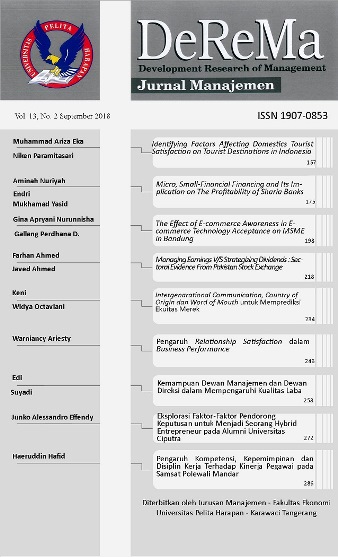The Effect of E-Commerce Awareness in E-Commerce Technology Acceptance on MSME in Bandung
DOI:
https://doi.org/10.19166/derema.v13i2.1093Kata Kunci:
e-commerce, TAM, Awareness, Perceived Usefulness, Perceived Ease of Use, Behavior IntentionAbstrak
Electronic-commerce (E-Commerce) has become an important channel for conducting business. Researchers as well as market executives are trying to find e-commerce consumer behavior, especially Micro Small Medium Enterprise (MSME) in Bandung. The aim of this paper is to investigate what factors affect the technology acceptance of e-commerce in Bandung, which intended to identify what improvement can be made for the future. The data for this research were collected from 133 respondents MSMEs that never use e-commerce for their business process. The research model is based on Technology Acceptance Model (TAM). Results showed that awareness has positive indirect influence to intention use but, perceived usefulness has insignificant affect towards intention to use. In conclusion, from the percentage of influence toward behavioral intention, perceived usefulness has higher total effect value compared to perceived ease of use, that is 56%. Based on previous analyzes also known that can directly affect the perceived usefulness of behavioral intention, in contrast to the perceived ease of use that must pass variables perceived usefulness beforehand. Therefore, the most important for MSMEs is the increasing number of benefits when they use e-commerce.
Abstrak dalam Bahasa Indonesia : Electronic-commerce (E-Commerce) telah menjadi saluran penting untuk melakukan bisnis. Para peneliti serta para eksekutif pasar berusaha mencari perilaku konsumen e-commerce, khususnya Usaha Mikro Kecil Menengah (UMKM) di Bandung. Tujuan dari penelitian ini adalah untuk menyelidiki faktor-faktor apa yang mempengaruhi penerimaan teknologi e-commerce di Bandung, yang dimaksudkan untuk mengidentifikasi perbaikan apa yang dapat dilakukan untuk masa depan. Data untuk penelitian ini dikumpulkan dari 133 responden UMKM yang belum pernah menggunakan e-commerce untuk proses bisnis mereka. Model penelitian didasarkan pada Technology Acceptance Model (TAM). Hasil penelitian menunjukkan bahwa Kesadaran (awareness) memiliki pengaruh positif tidak langsung terhadap niat menggunakan (intention to use) e-commerce tetapi, kegunaan yang dirasakan (perceived usefulness) memiliki pengaruh yang tidak signifikan terhadap niat menggunakan (intention to use). Kesimpulannya, dari persentase pengaruh terhadap niat menggunakan (intention to use), kegunaan yang dirasakan (perceived usefulness) memiliki nilai total efek yang lebih tinggi dibandingkan dengan persepsi kemudahan penggunaan (perceived ease of use), yaitu 56%. Berdasarkan analisis sebelumnya juga diketahui bahwa secara langsung dapat mempengaruhi kegunaan yang dirasakan dari niat perilaku, berbeda dengan persepsi kemudahan penggunaan yang harus melewati variabel yang dirasakan kegunaan sebelumnya. Oleh karena itu, yang paling penting bagi UMKM adalah meningkatnya jumlah manfaat ketika mereka menggunakan e-commerce.
Referensi
Adam, D. A., Nelson, R. R., & Todd, P. A. (1992). Perceived usefulness, ease of use, and usage of information technology: A replication. MIS Quarterly, 16(2), 227-247. https://doi.org/10.2307/249577
Ahn, T., Ryu, S., & Han, I. (2004). The impact of the online and offline features on the user acceptance of Internet shopping malls. Electronic Commerce Research and Applications, 3(4), 405-420. https://doi.org/10.1016/j.elerap.2004.05.001
Ajzen I, & Fishbein M. (1980). Understanding attitudes and predicting social behavior. Englewood Cliffs, NJ: Prentice-Hall.
Ajzen, I. (2005). Attitudes, personality and behavior (2nd ed.). Berkshire, England: Open University Press.
Al-Somali, S. A., Gholami, R., & Clegg, B. (2009). An investigation into the acceptance of online banking in Saudi Arabia. Technovation, 29(2), 130-141. https://doi.org/10.1016/j.technovation.2008.07.004
Brown I, & Jayakody R.(2009). B2C e-Commerce success: A test and validation of a revised conceptual model. Electronic Journal of Information Systems Evaluation, 11(3),167-184.
Central Bureau of Statistics Regional Bandung, 2016.
Chen, C. (2013). Perceived risk, usage frequency of mobile banking services. Managing Service Quality: An International Journal, 23(5), 410-436. https://doi.org/10.1108/MSQ-10-2012-0137
Chiou, W.-C., Perng, C., & Lin, C.-C. (2009). The relationship between technology acceptance model and usability test - case of performing E-learning task with PDA. 2009 WASE International Conference on Information Engineering. https://doi.org/10.1109/icie.2009.207
Davis, F. D. (1989). Perceived usefulness, perceived ease of use, and user acceptance of information technology. MIS Quarterly, 13(3), 319. https://doi.org/10.2307/249008
Hair, J. T., Anderson, R. E., Tatham, R. L. & Black, W. C. (1992). Multivariate data analysis with readings (3rd ed.). New York: Macmillan.
Hill, R. J., Fishbein, M., & Ajzen, I. (1977). Belief, attitude, intention and behavior: An introduction to theory and research. Contemporary Sociology, 6(2), 244. https://doi.org/10.2307/2065853
Gefen, D., Karahanna, E., & Straub, D. W. (2003). Trust and TAM in Online Shopping: An Integrated Model. MIS Quarterly, 27(1), 51. https://doi.org/10.2307/30036519
Henseler, J., Ringle, C. M., & Sinkovics, R. R. (2009). The use of partial least squares path modeling in international marketing. Advances in international marketing, 20, 277-319. http://dx.doi.org/10.1108/S1474-7979(2009)0000020014
Hong, S., Thong, J. Y. L., & Tam, K. Y. (2006). Understanding continued information technology usage behavior: A comparison of three models in the context of mobile internet. Decision Support Systems, 42(3), 1819-1834. https://doi.org/10.1016/j.dss.2006.03.009
Huang, D.-L., Patrick Rau, P.-L., Salvendy, G., Gao, F., & Zhou, J. (2011). Factors affecting perception of information security and their impacts on IT adoption and security practices. International Journal of Human-Computer Studies, 69(12), 870-883. https://doi.org/10.1016/j.ijhcs.2011.07.007
Ibna, A. (2009). Penggunaan kerangka technology acceptance model di dalam melakukan faktor-faktor yang mempengaruhi adopsi e-government pemko Medan. Medan, Indonesia: Universitas Sumatera Utara Medan.
Jackson, C. M., Chow, S., & Leitch, R. A. (1997). Toward an Understanding of the behavioral intention to use an information system. Decision Sciences, 28(2), 357-389. https://doi.org/10.1111/j.1540-5915.1997.tb01315.x
Jung, Y., Perez-Mira, B., & Wiley-Patton, S. (2009). Consumer adoption of mobile TV: Examining psychological flow and media content. Computers in Human Behavior, 25(1), 123-129. https://doi.org/10.1016/j.chb.2008.07.011
Koufaris, M. (2002). Applying the technology acceptance model and flow theory to online consumer behavior. Information Systems Research, 13(2), 205-223. https://doi.org/10.1287/isre.13.2.205.83
Lal, K. (1999). Determinants of the adoption of information technology: A case study of electrical and electronic goods manufacturing firms in India. Research Policy, 28(7), 667-680. https://doi.org/10.1016/S0048-7333(99)00014-1
Lal, K. (2005). Determinants of the adoption of e-business technologies. Telematics and Informatics, 22(3), 181-199. https://doi.org/10.1016/j.tele.2004.07.001
Laudon, K. C., & Traver, C. G. (2014). E-commerce: Business, Technology, Society (10th ed.). Boston, MA: Pearson Education, Inc.
Laukkanen, T., Sinkkonen, S., Kivijarvi, M., & Laukkanen, P. (2007). Segmenting bank customers by resistance to mobile banking. International Conference on the Management of Mobile Business (ICMB 2007). https://doi.org/10.1109/icmb.2007.57
Lee, Y., Kozar, K. A., & Larsen, K. R. T. (2003). The technology acceptance model past, present, future. Communication of The Association for Information System (CAIS), 12, 752-780.
Legris, P., Ingham, J., & Collerette, P. (2003). Why do people use information technology? A critical review of the technology acceptance model. Information & Management, 40(3), 191-204. https://doi.org/10.1016/S0378-7206(01)00143-4
López-Nicolás, C., Molina-Castillo, F. J., & Bouwman, H. (2008). An assessment of advanced mobile services acceptance: Contributions from TAM and diffusion theory models. Information & Management, 45(6), 359-364. https://doi.org/10.1016/j.im.2008.05.001
Ministry of Cooperatives and Small and Medium Enterprises, 2016.
Porter, C. E., & Donthu, N. (2006). Using the technology acceptance model to explain how attitudes determine Internet usage: The role of perceived access barriers and demographics. Journal of Business Research, 59(9), 999-1007.https://doi.org/10.1016/j.jbusres.2006.06.003
Qazi, W., Raza, S. A., & Shah, N. (2018). Acceptance of e-book reading among higher education students in a developing country: The modified diffusion innovation theory. International Journal of Business Information Systems, 27(2), 222. https://doi.org/10.1504/ijbis.2018.10009810
Sekaran, U. (1992). Research methods for business. New York: John Willey & Sons.
Sekaran, U. (2003). Research method for business: A skill building approach. New York: John Wiley and Sons, Inc.
Undang-Undang Republik Indonesia Nomor 20 Tahun 2008 Tentang Usaha Mikro, Kecil Dan Menengah Pasal 6 Tahun 2008.
Woodroof, J. B., & Kasper, G. M. (1998). A conceptual development of process and outcome user satisfaction. Information Resources Management Journal, 11(2), 37-43. https://doi.org/10.4018/irmj.1998040104
Venkatesh, V., & Davis, F. D. (1996). A model of the antecedents of perceived ease of use: Development and test. Decision Sciences, 27(3), 451-481. https://doi.org/10.1111/j.1540-5915.1996.tb01822.x
Venkatesh, V., & Morris, M. G. (2000). Why don't men ever stop to ask for directions? Gender, social influence, and their role in technology acceptance and usage behavior. MIS quarterly, 24(1), 115-139. https://doi.org/10.2307/3250981
Yamin, S. & Kurniawan, H. (2011). Generasi baru mengolah data penelitian dengan PARTIAL LEAST SQUARE PATH MODELING aplikasi dengan software XLSTAT, SmartPLS dan Visual PLS. Jakarta, Indonesia: Salemba Infotek.
Yuan, Y.-H., Tsai, S.-B., Dai, C.-Y., Chen, H.-M., Chen, W.-F., Wu, C.-H., & Wang, J. (2017). An empirical research on relationships between subjective judgement, technology acceptance tendency and knowledge transfer. PLOS ONE, 12(9), 1-22. https://doi.org/10.1371/journal.pone.0183994
Unduhan
Diterbitkan
Terbitan
Bagian
Lisensi
Authors who publish with this journal agree to the following terms:
1) Authors retain copyright and grant the journal right of first publication with the work simultaneously licensed under a Creative Commons Attribution License (CC-BY-SA 4.0) that allows others to share the work with an acknowledgement of the work's authorship and initial publication in this journal.
2) Authors are able to enter into separate, additional contractual arrangements for the non-exclusive distribution of the journal's published version of the work (e.g., post it to an institutional repository or publish it in a book), with an acknowledgement of its initial publication in this journal.
3) Authors are permitted and encouraged to post their work online (e.g., in institutional repositories or on their website). The final published PDF should be used and bibliographic details that credit the publication in this journal should be included.





